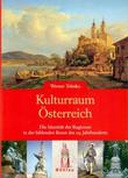Explore

Während im ersten Band der Gesamtpublikation, der unter dem Titel "Geschichtsraum Österreich" im Jahr 2006 erschienen ist, der habsburgische "Gesamtstaat" aus dem Blickpunkt der wichtigsten Phänomene und Protagonisten der "habsburgischen Ikonographie" im Zentrum des Interesses stand, werden im vorliegenden zweiten und abschließenden Band die vielfältigen Visualisierungen der regionalen und überregionalen historischen Mythen im 19. Jahrhundert im Zentrum Wien und in den Regionen, den österreichischen Kronländern (zum Teil mit den heutigen Bundesländern der Republik Österreich), untersucht. Das schwierige Verhältnis zwischen dem "Gesamtstaat" und den Ländern konstituiert das gesamte und höchst vielschichtige Spektrum der österreichischen Geschichtsreflexionen im 19. Jahrhundert. Wie und mit welchen konkreten Zielsetzungen regionale Gedächtnisstiftungen mit dynastischen Strategien zusammenwirken oder diese konkurrenzieren, ist eine wesentliche und bisher viel zu selten untersuchte Fragestellung. In der vorliegenden Arbeit sollen somit sowohl kunstgeschichtliche als auch historische Phänomene zur Sprache kommen, die einerseits die vielfältigen Geschichtsreflexionen an der - häufig vernachlässigten - "Peripherie" in den Blickpunkt nehmen, und andererseits den visuellen Umgang mit der "eigenen" Geschichte (etwa anhand der prominenten Ereignisse der zweiten Türkenbelagerung 1683 und der "Befreiungskriege" gegen Napoleon) aus der "Gegenwart" des 19. Jahrhunderts beleuchten. Anhand unterschiedlichster Themenkreise kann deutlich gemacht werden, in welcher komplexen Weise, mit welchem Grad der quantitativen Durchdringung und mit welchen signifikanten Gegensätzen zwischen dem "Zentrum" Wien und der "Provinzen" die österreichische Geschichte im Spannungsfeld von nationalen, regionalen und kommunalen Strategien reflektiert wurde. Die Perspektive auf den vielfältigen "Geschichtsraum Österreich" verlagert sich - im Vergleich zum ersten Band - vom "Gesamtstaat" zur Analyse der höchst unterschiedlichen und eigengesetzlichen "Pluralität der Räume" (Karl Schlögel). Diese Vielfalt ist auch für die Untersuchung der reichen Produktion der österreichischen Landschaftskunst im 19. Jahrhundert hinsichtlich ihrer identitätsstiftenden Gehalte wesentlich und zeigt in anschaulicher Weise, daß ein tiefes Verständnis der föderalen Strukturen Österreichs nicht ohne einen umfassenden Blick des 19. Jahrhunderts möglich ist.
This book is included in DOAB.
Why read this book? Have your say.
You must be logged in to comment.
Rights Information
Are you the author or publisher of this work? If so, you can claim it as yours by registering as an Unglue.it rights holder.Downloads
- 95 - pdf (CC BY-NC-ND) at OAPEN Library.
- 145 - pdf (CC BY-NC-ND) at OAPEN Library.
- 135 - pdf (CC BY-NC-ND) at OAPEN Library.
Keywords
- art history
- Austrian History
- European History of the 19th Century
- History Painting
- Monuments
- Österreich
- The arts
- The Austrian Crownlands
- thema EDItEUR::A The Arts
- Wien
Links
DOI: 10.26530/oapen_437146Editions

